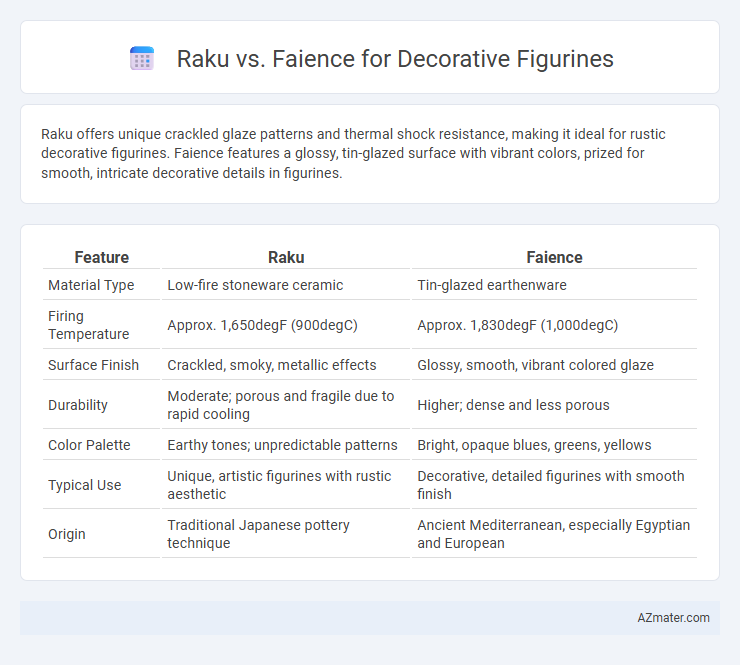Raku offers unique crackled glaze patterns and thermal shock resistance, making it ideal for rustic decorative figurines. Faience features a glossy, tin-glazed surface with vibrant colors, prized for smooth, intricate decorative details in figurines.
Table of Comparison
| Feature | Raku | Faience |
|---|---|---|
| Material Type | Low-fire stoneware ceramic | Tin-glazed earthenware |
| Firing Temperature | Approx. 1,650degF (900degC) | Approx. 1,830degF (1,000degC) |
| Surface Finish | Crackled, smoky, metallic effects | Glossy, smooth, vibrant colored glaze |
| Durability | Moderate; porous and fragile due to rapid cooling | Higher; dense and less porous |
| Color Palette | Earthy tones; unpredictable patterns | Bright, opaque blues, greens, yellows |
| Typical Use | Unique, artistic figurines with rustic aesthetic | Decorative, detailed figurines with smooth finish |
| Origin | Traditional Japanese pottery technique | Ancient Mediterranean, especially Egyptian and European |
Introduction to Raku and Faience
Raku is a Japanese pottery technique characterized by its distinctive crackled glaze and rapid cooling process, creating unique textures and vibrant colors ideal for decorative figurines. Faience, a type of tin-glazed earthenware originating from France and Italy, is known for its smooth, glossy surface and intricate painted designs, often depicting floral or historical motifs. Both materials offer distinct aesthetic qualities, with Raku emphasizing organic imperfection and Faience showcasing fine, detailed artistry.
Historical Origins of Raku and Faience
Raku pottery originated in 16th-century Japan, characterized by its unique hand-shaped forms and rapid firing techniques producing unpredictable textures and colors favored in tea ceremonies. Faience, rooted in ancient Egypt and flourishing in Renaissance Europe, is a tin-glazed earthenware admired for its bright, opaque glaze and intricate painted designs. Both materials hold rich cultural heritages influencing decorative figurine craftsmanship, with Raku emphasizing natural, organic aesthetics while Faience showcases detailed, vibrant surface decoration.
Material Composition and Techniques
Raku figurines are crafted from porous, low-fired clay that is removed from the kiln while hot and subjected to rapid cooling or reduction, creating unique crackled glazes and smoky patterns. Faience, a tin-glazed earthenware, features an opaque, glossy surface achieved through a tin oxide glaze fired at a lower temperature, producing bright, vivid colors ideal for detailed decorative effects. The distinct firing techniques and clay compositions result in Raku's rustic, organic textures versus Faience's smooth, vibrant finishes, making material choice essential for the desired aesthetic in decorative figurines.
Firing Methods: Raku vs Faience
Raku firing involves rapid heating and cooling, creating unique crackles and metallic finishes through direct removal from the kiln into cool air or water, enhancing the figurine's texture and visual depth. Faience firing uses a low-temperature glaze vitrification process, often involving multiple firings to achieve a smooth, glossy surface typical of ancient Egyptian-inspired decorative pieces. These distinct firing methods influence the final aesthetic and durability, with Raku offering organic irregularities and Faience providing vibrant, glass-like finishes.
Surface Finishes and Aesthetic Differences
Raku figurines are characterized by their unique, crackled surface finish achieved through rapid cooling after firing, resulting in unpredictable metallic sheens and smoky patterns that emphasize organic textures. Faience figurines feature a smooth, glossy glaze with vibrant, often opaque colors inspired by ancient Egyptian art, offering a polished and uniform appearance. The aesthetic difference lies in Raku's rustic, artisanal charm contrasting with Faience's refined, museum-quality elegance and bright color palette.
Durability and Longevity of Decorative Figurines
Raku ceramics, known for their rapid cooling process and porous surface, generally exhibit lower durability and are more prone to chipping and cracking compared to faience. Faience, a glazed non-clay ceramic made from finely ground quartz, offers superior strength and a more resilient, glossy finish that resists wear and fading over time. For decorative figurines intended to last, faience provides enhanced longevity due to its robust glaze and structural integrity.
Artistic Applications and Trends
Raku ceramics, celebrated for their unpredictable crackle patterns and metallic luster, offer artists unique textures and organic aesthetics, making them ideal for contemporary decorative figurines exploring natural imperfection. Faience, with its vibrant, glazed surface colors and smooth finish, remains prominent in traditional and classical figurine art, emphasizing intricate detailing and historical motifs. Current artistic trends blend Raku's chaotic beauty with Faience's bright palette to create hybrid figurines that push boundaries in decorative art collections and gallery exhibitions.
Suitability for Intricate Detailing
Faience offers a smooth, fine-grained texture that allows for precise, intricate detailing in decorative figurines, making it ideal for complex patterns and delicate features. Raku firing produces unique crackle effects and organic textures, but its porous surface can limit the crispness of fine details. For figurines requiring elaborate, sharply defined ornamentation, faience is generally more suitable due to its malleable clay composition and controlled kiln firing.
Environmental Impact and Sustainability
Raku pottery, known for its unique firing process and use of natural materials, often involves rapid cooling techniques that consume less energy compared to traditional kiln firings used in faience production. Faience, typically glazed with lead-based compounds and requiring multiple firings at high temperatures, can have a higher environmental footprint due to increased energy consumption and potential toxic waste. Choosing raku over faience for decorative figurines supports more sustainable practices by minimizing energy use and reducing hazardous material output.
Choosing the Right Technique for Decorative Figurines
Raku firing offers unique crackled textures and unpredictable glaze effects ideal for rustic and tactile decorative figurines, while faience provides smooth, vividly colored surfaces with precise detailing suited for intricate and polished designs. Consider Raku for organic, one-of-a-kind aesthetics that benefit from thermal shock patterns, whereas faience excels in creating glossy, vibrant finishes with durable ceramic materials. Selecting the right technique depends on the desired visual impact, surface texture, and color vibrancy needed for the figurine's artistic expression.

Infographic: Raku vs Faience for Decorative Figurine
 azmater.com
azmater.com